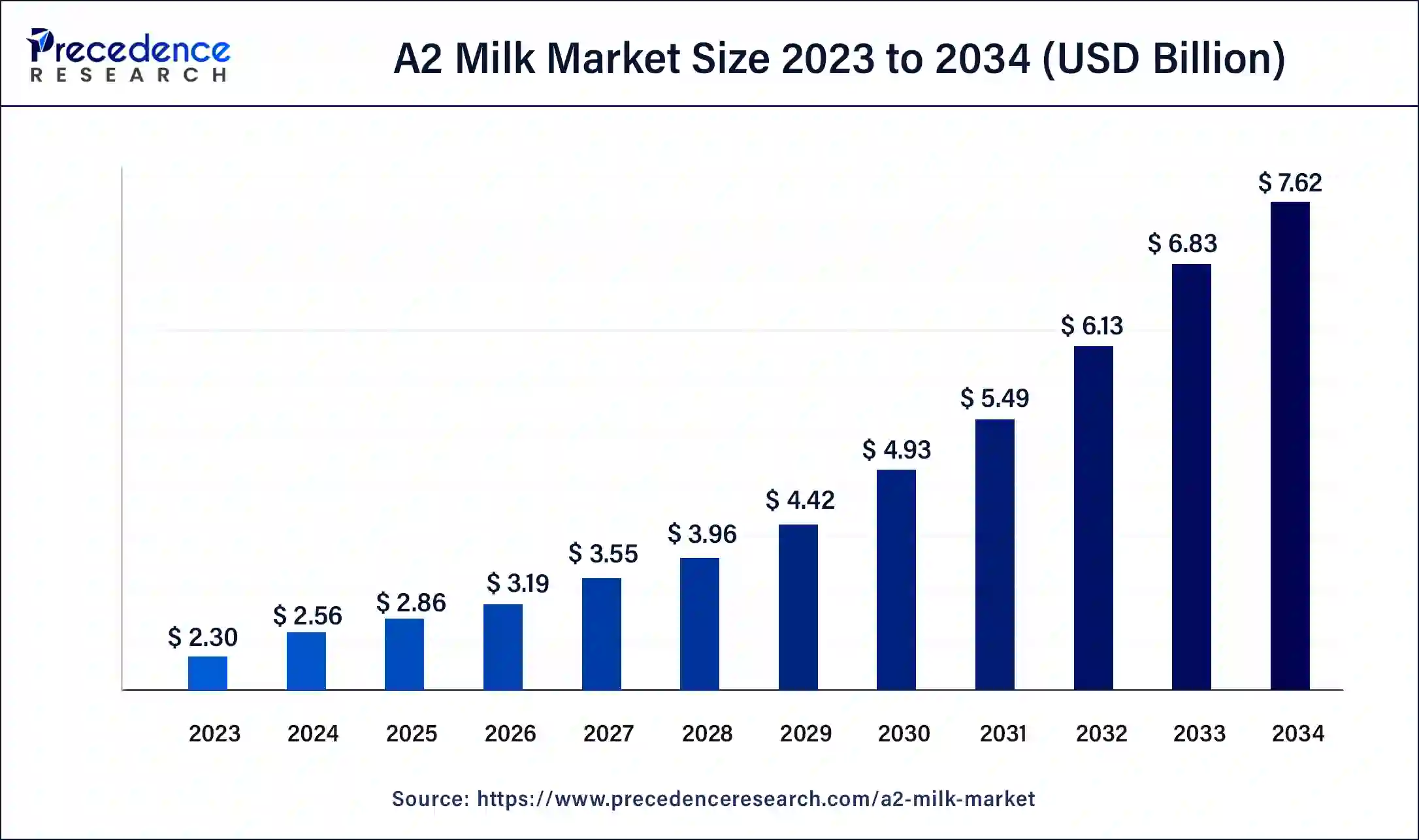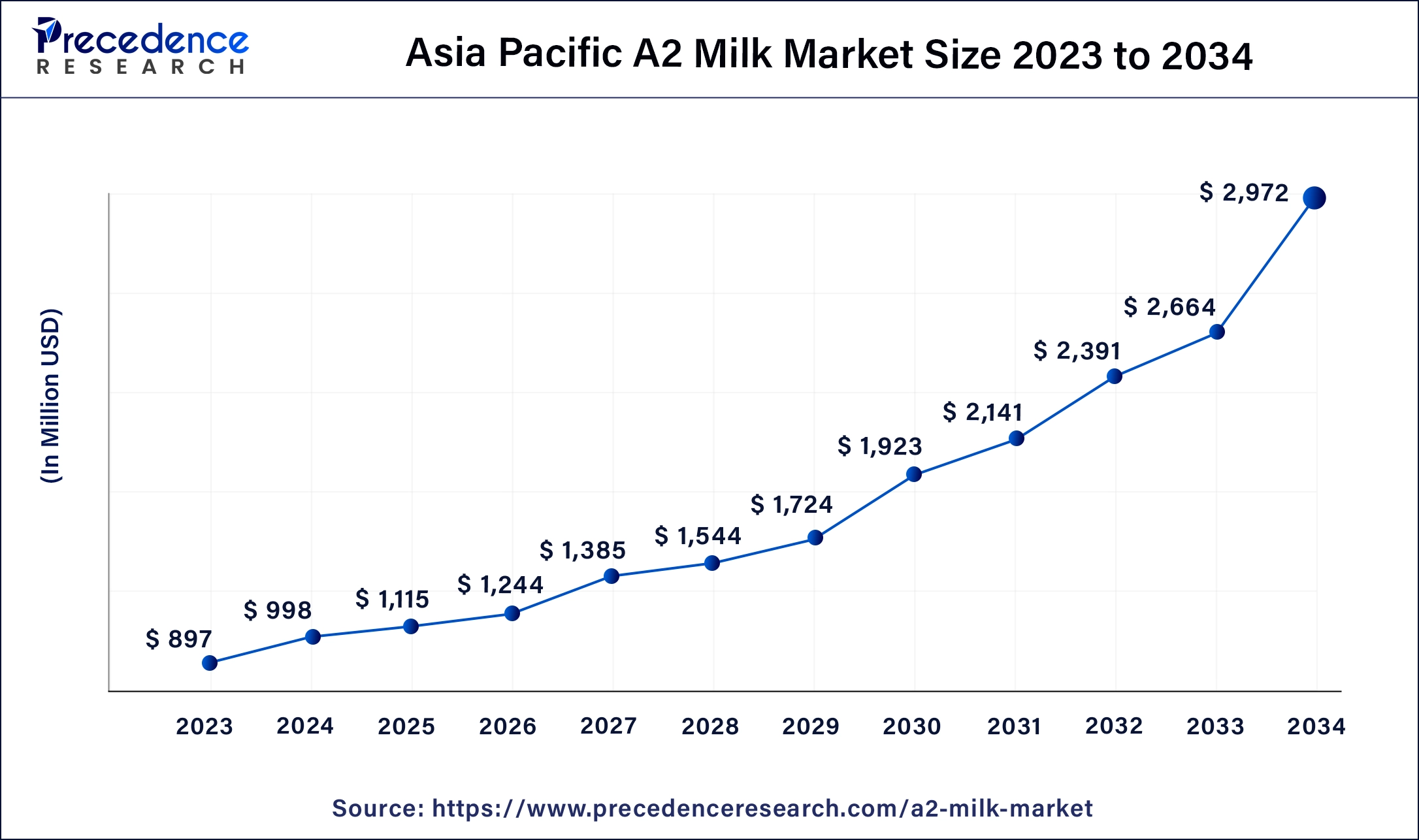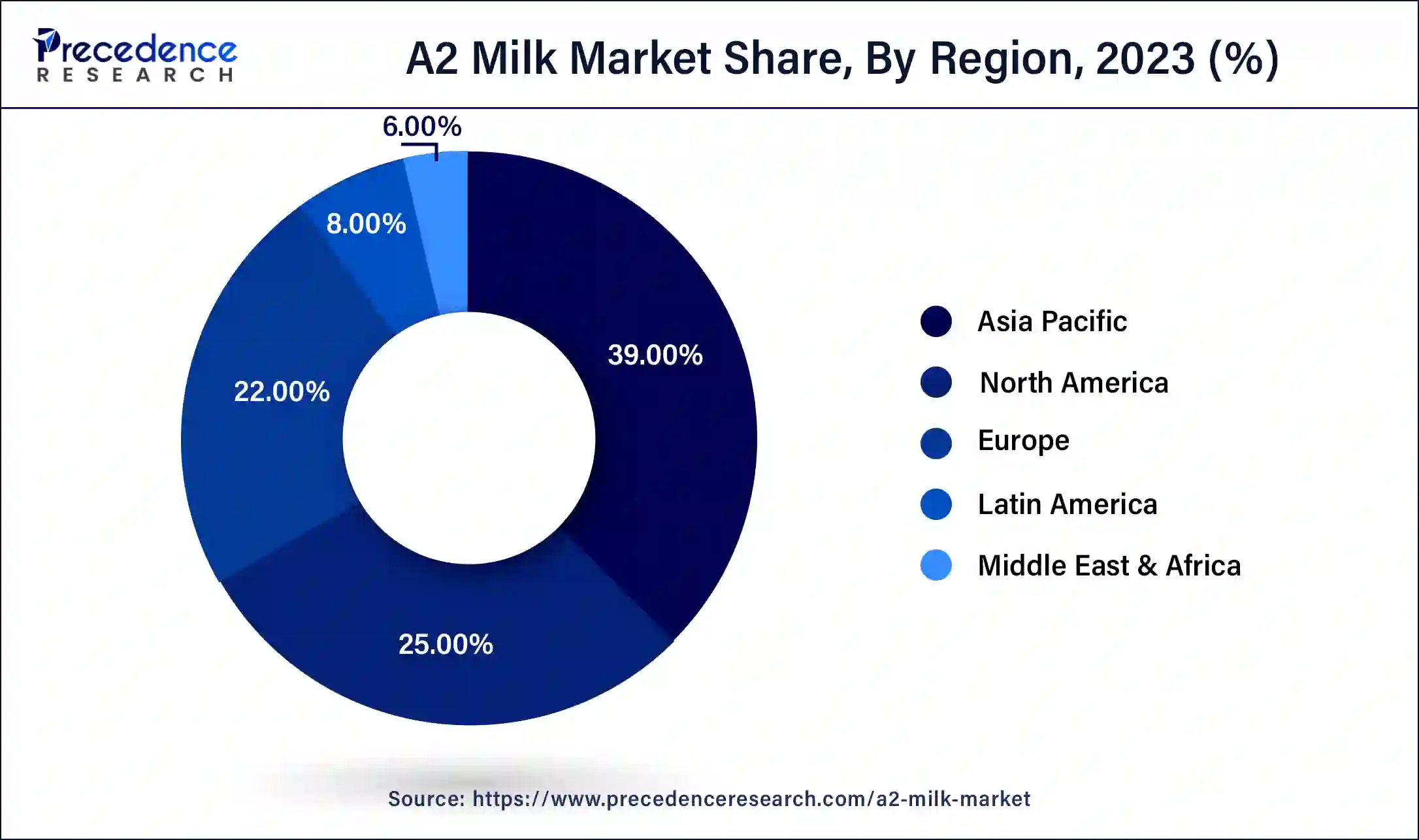April 2024
The global A2 milk market size was USD 2.30 billion in 2023, calculated at USD 2.56 billion in 2024 and is projected to surpass around USD 7.62 billion by 2034, expanding at a CAGR of 11.5% from 2024 to 2034.
The global A2 milk market size accounted for USD 2.56 billion in 2024 and is expected to be worth around USD 7.62 billion by 2034, at a CAGR of 11.5% from 2024 to 2034. The rising awareness about health and well-being, increasing health consciousness among the population, and growing usage of A2 milk in infant formula are expected to drive the growth of the A2 milk market during the forecast period.

The Asia Pacific A2 milk market size was estimated at USD 897 million in 2023 and is predicted to be worth around USD 2,972 million by 2034, at a CAGR of 11.7% from 2024 to 2034.

Asia Pacific dominated the A2 milk market in 2023 due to the increasing demand for dairy products and the wide availability of A2 breed cows in the region. Moreover, the increasing awareness about the benefits of A2 beta-casein milk among the population, growing health-conscious population, and rising production of A2 milk in emerging countries, such as India and China, contributed to the regional market growth.
The market in Europe is expected to expand at the fastest growth rate during the forecast period due to the presence of the state-of-the-art dairy infrastructure. Furthermore, the rising demand for dairy products boosts the market. On the other hand, North America is anticipated to witness a rapid growth rate in the coming years due to the high spending on premium food products, rising awareness about the availability of healthy food options, and increasing cases of lactose intolerance.

Market Overview
Milk that contains only A2 beta-casein polypeptide is called A2 milk. A2 milk is a type of cow's milk that generally lacks a type of β-casein polypeptide called A1, and has majorly the A2 form. A2 milk has 12% more protein, 25% more vitamin A, 15% more calcium, 33% more vitamin D and 30% more cream. Also, research on A2 milk consumption have shown that regular consumption of A2 milk can assist in slowing down of muscle catabolism, thus improving muscle recovery. Milks from Guernsey, Jersey, Asian herds etc. comprise majorly A2 beta casein. A2 milk consists of beta casein protein that varies by one amino acid at 67th place in chains of amino acids. When we compare A1 milk with A2 milk, A2 is better digested as compared to A1. Digestion of A1 occurs in intestine and peptide named beta-casomorphin-7 (BCM-7) is produced enzymatically from the A1 β-casein variant. Beta-casomorphin (BCM) protein belongs to opioid peptide group and has been reported that presence of BCM-7 causes stomach discomfort, lactose intolerance, and other gastrointestinal problems and is assumed to be associated with increased risk of type 1 diabetes and heart diseases. A2 β-casein variant do not cause such discomfort and therefore is more preferable as compared to A1.
A2 milk has high nutritional content which is essential for the growth of an infant. A2 milk has health benefits because of high protein content, easily digestible properties, good source of calcium, important vitamins and minerals etc. and is similarly free of antibiotics and hormones. A2 milk has 12% additional protein, 25% extra vitamin A, 15% more calcium, 33% more vitamin D and 30% more good fat content. Thus, it is being widely used to manufacture the infant formula helping drive the market growth of A2 milk. Milk is an important dietary staple and integral part of baby food. Milk with A1 beta casein has shown to release increased levels of BCM-7 in infants which are linked with various stomach related disorders. Whereas, A2 milk digestion releases lower levels of BCM-7. Thus, A2 milk is widely preferred in infant formulas by baby food manufacturers, which has led to increase in demand for A2 milk which will boost market the market growth in the coming years.
| Report Highlights | Details |
| Market Size in 2023 | USD 2.30 Billion |
| Market Size in 2023 | USD 2.56 Billion |
| Market Size by 2034 | USD 7.62 Billion |
| Growth Rate from 2024 to 2034 | CAGR of 11.5% |
| Largest Market | Asia Pacific |
| Base Year | 2023 |
| Forecast Period | 2024 to 2034 |
| Segments Covered | Form, Application, Packaging, Distribution Channel |
| Regional Scope | North America, Europe, Asia Pacific, Latin America, Middle East & Africa (MEA) |
Growing consumer preferences
A2 milk is gaining immense attention as consumer preferences evolve toward ethical, organic, and natural choices. Various brands produce A2 milk-based products in environmentally responsible ways. Some even focus on better animal welfare practices, such as grass-fed cows, appealing to a customer base concerned with ethical considerations and sustainability. Moreover, the rising awareness about the benefits of consuming A2 milk is expected to drive the market. A2 milk strengthens teeth and bones and promotes cell and tissue growth. A2 milk is equivalent to a mother’s milk. Thus, it is widely used in infant formulae. Several players focus on developing A2 milk-based products to meet the increasing demand.
High cost of A2 milk
Indian-origin cows produce A2 milk; however, the production per cow is minimal. Moreover, the nutritious nature of A2 milk raises its overall value, thereby increasing its adoption in infant formulae and dietary products. These factors may create a gap between demand and supply. However, the gap between demand and supply of A2 milk further increases the final product's costs, leading to a higher cost of A2 milk than A1 milk, thus restraining the market growth.
Inclination toward sustainable production of A2 milk
Sustainability helps with community and individual well-being. It promotes a better economy with equitable wealth distribution, fewer emissions, and less waste and pollution. Moreover, a sustainable milk production approach can minimize the environmental impact of dairy farming and increase social endorsement and animal welfare. Customers with higher moral standards demand A2 milk dairy products. Thus, various companies producing A2 milk-based products focus on sustainability in their packaging, processing, production, and other procedures, contributing to enhancing the growth of the A2 milk market in the coming years. For instance,
The liquid segment held the largest market share in 2023. Increasing preference for a liquid form of A2 milk contributed to the segment’s growth. Liquid form of milk highly preferred for direct consumption. It helps customers derive maximum nutrients, such as calcium, proteins, minerals, and vitamins. These vitamins support the maintenance of the nervous system’s health. Fresh A2 milk also involves more selenium and phosphorus than powdered milk. The gentle taste and natural flavor of liquid A2 milk increase its adoption in beverages, accelerating the market growth.
The milk-based beverages segment accounted for a large share of the market in 2023 due to the increasing demand for flavored liquid formulae. A2 milk is consumed on a large scale in its original form and is also sold as a packaged product with added flavors. Moreover, processed milk, such as no-fat, full-cream, low-fat, and light varieties, is also very popular.
The infant formula segment is projected to expand at the highest CAGR during the forecast period, owing to the rising usage of A2 milk in infant formula. The A2 milk is widely being used in infant formulas due to multiple health benefits associated with it, such as high protein and vitamin content, easy digestibility, and absence of antibiotics. Moreover, it replaces mother’s milk.
The carton packaging segment led the market in 2023, holding the largest share. The high use of carton packaging for A2 milk is mainly due to its low cost and is easy to transportation. Moreover, the rising usage of environmentally friendly packaging materials contributed to the growth of the carton packaging segment.
The cans segment is expected to expand at the highest CAGR during the forecast period due to their longer shelf life and reusability. Cans are widely used to pack liquid beverages. Furthermore, cans can be recycled, thereby reducing waste and aligning well with sustainable packaging.
The hypermarkets and supermarkets segment led the market in 2023, accounting for a major market share. The rapid expansion of supermarkets and the availability of a wide range of products under a single roof are the major factors contributing to the segment’s growth. Moreover, hypermarkets and supermarkets often have separate shelves with controlled temperature for dairy-based products, which avoids spoilage. Thus, customers find it convenient to buy everyday needs in such shops.
The online stores segment is anticipated to expand at the fastest growth rate in the coming years due to the convenience provided by these stores. Online platforms often have a separate section for dairy-based products, allowing users to easily find the products they want. The increasing internet usage for shopping, higher convenience, and reduced lead time are major factors boosting the sale of A2 milk through online stores.
Major Market Segments Covered
By Form
By Application
By Packaging
By Distribution Channel
By Geography
For inquiries regarding discounts, bulk purchases, or customization requests, please contact us at sales@precedenceresearch.com
No cookie-cutter, only authentic analysis – take the 1st step to become a Precedence Research client
April 2024
January 2025
April 2024
July 2024